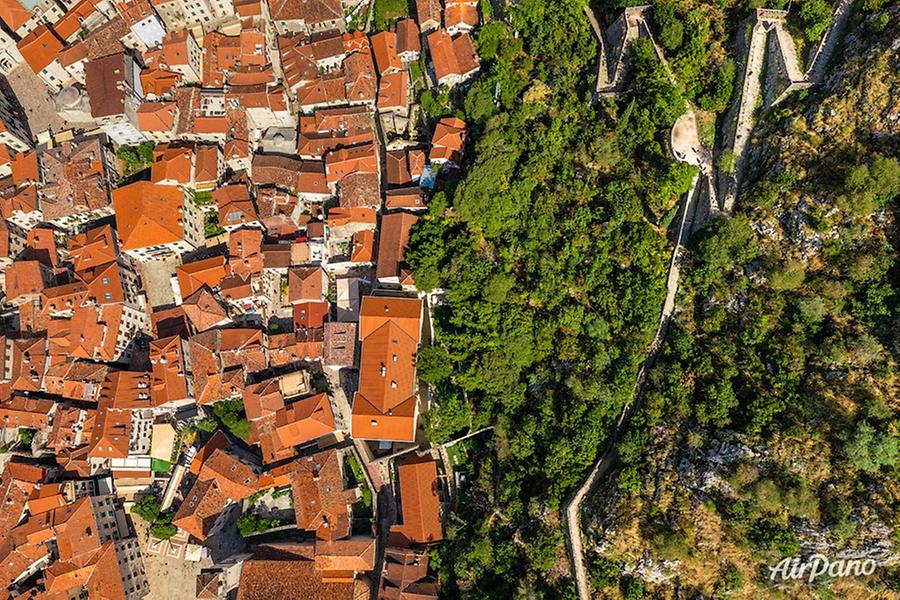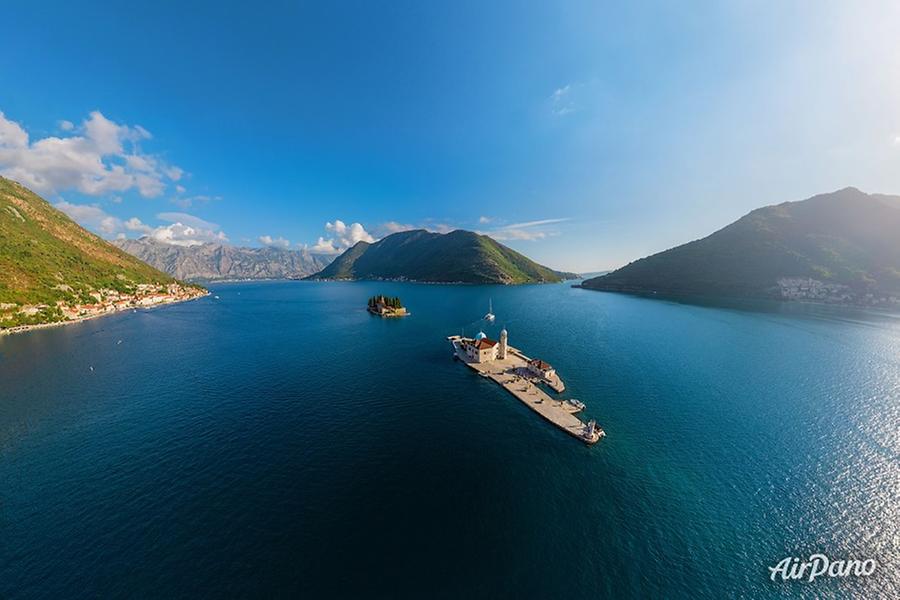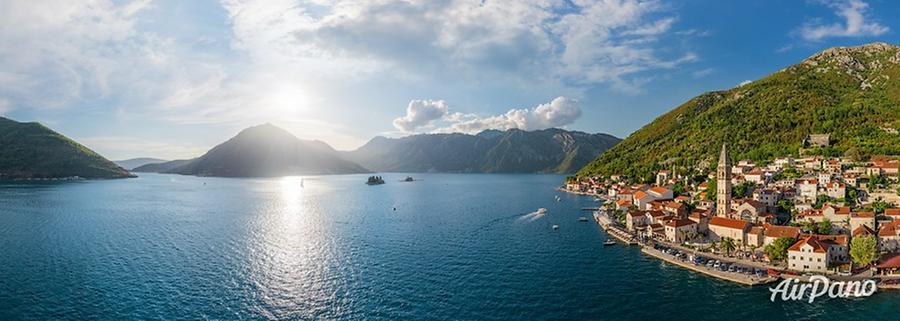Trip to Montenegro#
Photo and text by Stas Sedov.
member of the AirPano Team that is a member of the global-geography Consortium.
04 February 2022
with kind permission of AirPano
Filming in Montenegro began with a lot of paperwork required for the trip: you can't bring a drone into this country without permits. I found a local lawyer who, for a certain fee, plus a month or so of waiting, helped me resolve this issue, and I can tell you right away that if it hadn't been for these papers, there would have been no filming. The Tivat Airport security officers are well aware of what drones look like on the scanner screen, and call the customs officers. I had to deal with them both on arrival to and departure from the country, but thanks to the permits, I had no problems. Though, it was very funny to watch the frustrated faces of the customs officers when I was handing them the papers.
The main purpose of the trip was to film the vacation destinations on the coast near Tivat, as well as the Bay of Kotor. After considering the distance between Budva and Kotor and checking the availability of vacancies at hotels, I decided to stay in Budva, not far from the old downtown. There I managed to find a nice family-owned hotel with its own parking lot. Anyone who has traveled along the coast of Montenegro by car knows how much more convenient it is in addition to the hotel amenities.

© AirPano
I was very unlucky with the weather on the first day of my trip in September: the skies were heavily overcast, and at times it drizzled with rain. Instead of filming, I went to look for some locations in the old downtown of Budva. The first impression is that you can hear a lot of Russian speech, there are many Russian-speaking tourists. You can almost always find pages in Russian on restaurant menus. Many locals understand Russian.
The second impression was the weather. The air temperature was about +30°C (86°F) and it was hot and humid like in the tropics. The clothes were soaking wet after only about five minutes. But it wasn't the only upsetting thing: the updated weather forecast for the next few days once again predicted rain. We usually jokingly say that we bring along good weather "in our pockets" to the filming location, but this time something must have gone wrong. However, after a couple of days, it became clear that although the forecast was correct, the weather in Budva and the Bay of Kotor was changing pretty quickly: even if it rained in one place, after a 20 km (12.4 mi) drive, you could "catch" the sun and beautiful clouds at another location.

© AirPano
I did the filming in a weather chase mode. If it was cloudy in Budva, I would go to the Bay of Kotor, and it was usually sunny there. When the weather in Kotor turned bad, I rushed back to Budva: what if the sun had broken through there?
If I compare my impressions of the towns, I liked the downtown in Kotor better than in Budva. Both old towns are quite small in size, you can walk all around in half an hour. There is no car traffic – only pedestrians. There are quite a lot of tourists during the day, but in my opinion, in Kotor it is easier to get lost in the maze of streets; at times I even managed to take shots without people in sight. In terms of its architecture and atmosphere, the town reminded me very much of southern Italy: red tiled roofs; laundry hung outside the windows; neighbors talking to each other through the windows of their houses. Although it is a very popular tourist spot, I noticed that not all the houses have been converted to restaurants, hotels, and stores. Many are still inhabited by locals.

© AirPano
Another thing worth mentioning is the serpentine road that takes you up into the mountains above Kotor. After a few dozen sharp turns, somewhere in the middle of the road, you can see the stunning views of the Bay of Kotor. The road is very narrow, at times you have to back up to let yet another bus of tourists pass. Sometimes, there are long traffic jams, so the best time to drive up the mountains is early in the morning.
If you're lucky with the weather, you can practically touch the clouds floating overhead with your hand from the upper observation decks. If your luck is bad, you'll find yourself inside a cloud lingering on the side of the mountain. As I have said before, the weather is very changeable here: it's hard to guess what will happen in the bay in the next few hours.

© AirPano
The next destination of my trip was the small town of Perast. It can be reached from Kotor on a motorboat, or by a scenic road that skirts the Bay of Kotor. The main attraction of this place is the island with the hardly pronounceable name: , on which stands the Church of the Holy Mother of God. The island is man-made: it was built on top of a reef, next to which the citizens of Perast sunk captured pirate ships and their old ships for 200 years. A law was also passed that every ship that passed by the island was to drop a stone to the bottom here. The tradition of throwing stones near the island survives to this day.

© AirPano
A hundred meters (yards) from Gospa od Škrpjela is the island of St. George, home to a Benedictine Monastery. Unfortunately, the island is closed to the public; it can only be viewed from the water or from the air. Meanwhile, it is not a problem to get to the Church of the Holy Mother of God; however, there is a little trick here, which the inhabitants of Perast take advantage of to make a good profit on tourists. You can't drive into the city – there's just no room for everyone to park there. There is paid parking near the town, but you can often see signs offering free parking in the yards of locals if you buy a boat tour to the island from them. At the paid parking lots, local guys also offer not to pay if you buy a boat tour, but it will cost 2-2.5 times more than what is charged by boat companies downtown. Such a simple business!

© AirPano
After driving to Gospa od Škrpjela, I filmed it from the ground: when I was trying to launch a drone, an employee came out of the church store and asked me to land the aircraft. This is one of the few places in Montenegro where locals were against the launching of drones, although there were no warning signs against it. I was able to film the islands with a drone later, from the shore: they are about half a kilometer (546 yd) away from the parking lot.
I had a few extra days before flying home, and after talking to my colleagues, I decided to go to the north of Montenegro to film Durmitor National Park. After about 3.5 hours on the road, crossing several mountain passes and valleys, I arrive at Zabljak, a mountain resort town. You can feel the drastic change in temperature: it was +26°C (79°F) on the coast, and it is +4°C (39°F) in Zabljak. There is a very strong wind blowing from the north, and the skies are covered with gunmetal gray clouds. Indeed, the climate in sunny Montenegro can easily spring a surprise!
The weather was clearly bad, so I went to look for locations to film. The Tara River Canyon is impressive, but not as impressive as the Durmitor Mountain valleys. I'm not easily fascinated by beautiful mountains, but this place impressed me so much that now, for me, Montenegro is first of all Durmitor, rather than the coast and the Bay of Kotor! And there seems to be nothing special around: rocks with intricately intertwined patterns on the slopes, few trees, but the rocks are not bare – the mountains are covered with grass, mosses and some mountain flowers. Total seclusion, but at the same time you realize that civilization is close by – the hotel is only half an hour away.

© AirPano
There is a narrow asphalt road running through the valley in Durmitor. You can easily move around by car. The park itself has almost no cell service and very few buildings: I saw only a couple of roadside cafes and a few mountain hostels. Unlike on the coast, there weren't many tourists here, probably because of the off-season. It was already cold for outdoor walks, but it was too early for skiing.
I drove around the valley several times, marking favorite spots to be filmed in the future. I would like to thank my Ukrainian colleagues who told me about the location of a lonely tree: it's not easy to spot it from the road.
I had one day to film the park, and here I was lucky with the sun, but unlucky with the wind and the temperature – the car thermometer showed only +2°C (35°F). I had serious doubts whether to launch a large drone or not, but the aircraft more or less did the job. I spent the day racing from one previously scouted location to another; I wanted to do as much as I could. Of course, one day is not enough to film the park, which is about 390 sq. km (150 sq. mi), but I tried to show you the places that I particularly fell in love with. In the last rays of the sun, my drone shot Mount Sedlo from the pass of the same name. It was a magical sight.

© AirPano
The next day, as if on cue, the weather cleared up. The weather forecast even predicted a warming to +15°C (59°F) over the next few days. It was a shame, but I had to leave for the airport. The day before, my colleague and I had tried to reschedule our return tickets to have a little more time to film Durmitor, but unfortunately we had no luck.
Another drive, another big temperature change: in Tivat it's sunny and hot. Inspections, checks, conversations with customs officers – the usual airport routine. Finally, my plane takes off and heads for Belgrade, where I have a connection to Moscow. And I am lucky enough to see again all the places where I recently filmed, as, after making a U-turn over the sea, the plane flies over the Bay of Kotor, and then the familiar mountains with the prominent Sedlo peak, where yesterday I watched a fabulous sunset, appear on the horizon. I really hope this is not the last time I have seen these mountains...